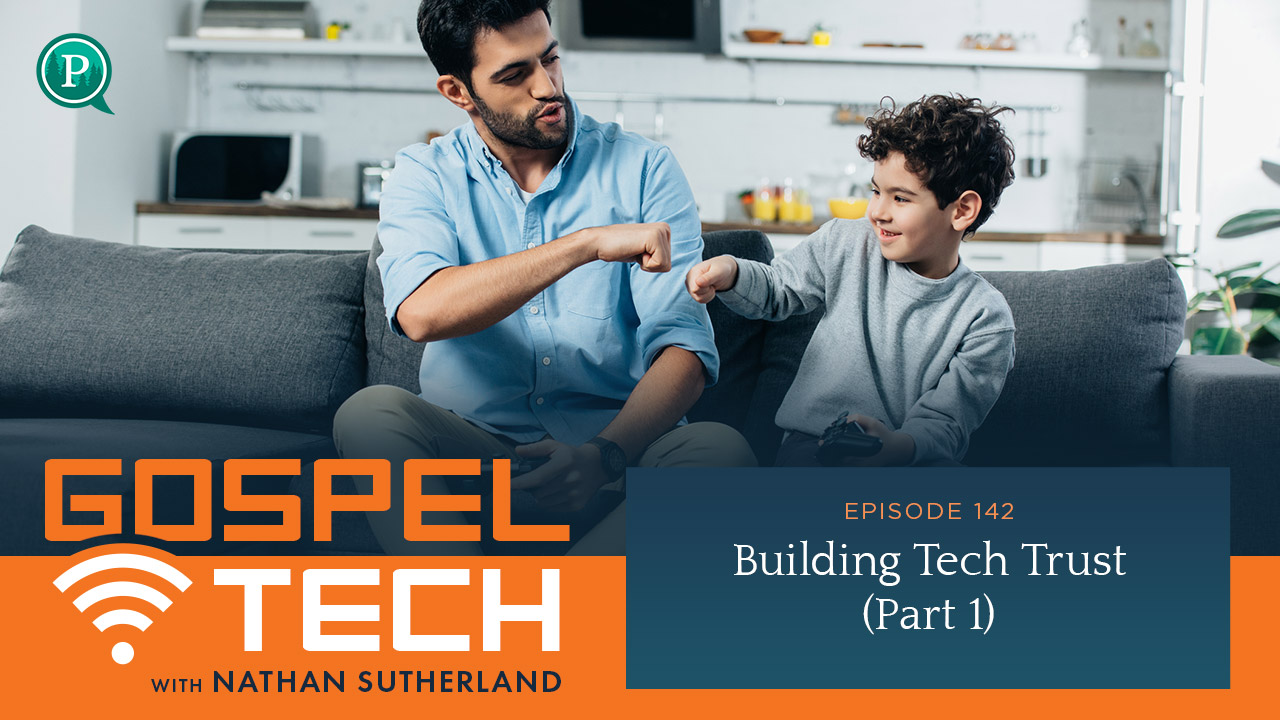How do we build tech trust with our children?
The first thing we do is make sure the tech is a good fit for our family, our child, and this season of life. We should not give our children devices that are inherently unsafe, go against family expectations, or damage or distract from his or her purpose in Christ.
In today’s conversation we’ll cover what it takes to ensure a new tech is a good fit for your family.
Today’s verse: Luke 16:10-12:
“One who is faithful in a very little is also faithful in much, and one who is dishonest in a very little is also dishonest in much. If then you have not been faithful in the unrighteous wealth, who will entrust to you the true riches? And if you have not been faithful in that which is another’s, who will give you that which is your own?”
Timeline:
0:00 – Introduction
2:15 – Thank You
3:00 – New Partner! Lome
3:50 – Building Tech Trust
6:00 – verse for today
8:30 – 3 Areas to Begin Building Tech Trust
9:30 – Safe tech?
12:00 – Family Fit?
13:30 – Child’s Purpose?
16:30 – Breach of trust
Show Links:
Follow Gospel Tech: Online | Instagram | Facebook | Twitter
Today’s Gospel Tech Partner: Lome, the platform for creating family life rhythms. Check them out for free at withlome.com.
Transcription:
Purposely. Your life. God’s purpose. Listen at onpurposely.com.
[00:00:00] Hello everyone and welcome to the Gospel Tech podcast. My name is Nathan Sutherland and this podcast is dedicated to helping families love God and used tech. Episode 142, we are discussing how we can build tech trust. This conversation comes out of talking to parents about bringing in new technology into the household, how to manage when technology has gone off the rails and still have a relationship with their young person.
Partly because as parents, we do have this fear in the back of our heads that our kids are just gonna write us off. If we set down rules, if we come in with some kind of an intervention, even when things are unhealthy, then we’re going to distance them. And on the other side, that we don’t know how to know if our kid is trustworthy with this technology. Like, do we just give it to them and hope for the best? Like, what are we doing here? So, tech trust is foundational to that concept. It’s a biblical idea that we can apply to our [00:01:00] technology coming from the hope of the gospel. This idea that our kids have a purpose, that it’s bigger than them just using tech well, but instead they use tech well because of their purpose. And tech trust can help us understand, is this a good tech to give to our child? Is this a good season to have this thing? And when it goes off the rails, it gives us a spot to fight for our child rather than just with them about their tech. So, we can continually move them towards their greater purpose, rather than just away from the bad stuff in the tech world.
So, that’s today’s conversation. At the end of the day, we’ll have a very practical idea both on new tech. How do we kind of assess when it’s a good idea and to talk about our tech trust, foundational work in our own family. So, yeah. With no further ado, let’s get this conversation started.
Welcome to the Gospel Tech Podcast, a resource for parents who feel overwhelmed and outpaced as they raise healthy youth in a tech world. As an educator, parent and tech user, I want to equip parents with the tools, resources, and confidence they need to raise [00:02:00] kids who love God and use tech.
Thank you to everyone who has helped make this podcast possible. Thank you for listening, for sharing, for reviewing and rating this podcast, for listening. I’ve got a couple Washington shoutouts today. Thank you to Leavenworth, Washington for listening! You guys, it’s been so cool cuz when you can watch these little pockets of the United States grow, it’s super cool cause like someone told a friend and that friend told somebody else, and that’s awesome. So, thanks Leavenworth.
Thanks Wenatchee! You guys are close. So, maybe you know, friends in the other town, but we are seeing you. Thank you for doing that and joining us on this ministry because what that means is, more people get to hear this message. They get to hear how the gospel can connect. They get to, the words and the work that they can do to love their kids, talk about technology and connect it to the hope of the gospel on a daily basis. And it helps other people find it. So, thanks for that.
For the first time ever, I’m excited to thank our partners. I’ve been really selective in this [00:03:00] process. In fact, it’s taken me years to get to this point because I wanna make sure only suggesting organizations are gonna help you love God and use tech to raise healthy youth in a tech world. Which is why I’m excited to introduce you to Lome. Lome is designed to help you create healthy family rhythms. It takes your family calendar and all the activities you’ve got and mashes them into one digital space that ties in with your Google Calendar. Or even just available via text message or your web browser, and it lets you build your family plan based on your family priorities. You can set up chores in there, You can set up meal planning. You can even look for activities drawn from organizations like Gospel Tech. So, you can go to withlome.com, WITHLOME.COM, and begin intentionally planning your family’s calendar today.
So, today on that topic, we are talking about how do we build tech trust. This comes out of a conversation I was having with a pair of pastors. We’re prepping for a workshop and the conversation they wanted to know is, Well, how do we know, How do we talk to parents about whether their kids are ready for this tech? And I was like, Well, we need to talk about [00:04:00] tech trust. Like we, we wanna make sure that our child is capable of handling this technology. And it was a kind of an aha moment in this conversation. Like, Oh, we, we don’t believe that people from our church are doing that. Like we, they just kind of, they think about it, they think about how they feel like kind of spidey sense style. And if they don’t really know, they default to Yes. And they’re like, That’s as far as we’re getting. And then, When you progress down the line, things start happening. Mistakes start being made, and they don’t know how to walk it back. And I was like, Oh this, this is the one. This is the same conversation.
How you give your kid New tech and how you build tech trust are the same conversation because you have to have tech trust in order to give them new technology, unless we’re not doing our job as parents. But as parents, we are called to love our children, to give them good gifts. Jesus says, That’s wired into us. We want to give our kids awesome stuff and when they ask us for an egg, we wanna give ’em an egg, not a snake. And so, we are not going to be giving our kids, childrens, kids and children mixed together our children, snakes. We are going to be intentionally [00:05:00] walking them through, raising them up in the way they should go, walking them through wise choices, investing in them in amazing adventure and seeing God like we talked about last week and helping them understand what trust means.
It doesn’t mean earning your love. It means proving that this is going to be a safe decision. So, we’re gonna break it into two parts. Your kid wants a new device, and we’re gonna make sure we have that idea. How do I know that’s safe? And then whether or not it’s safe, how do we build trust with this child? And when trust is damaged, how do we fix the damaged trust? So, our biblical standard for today, where we’re, where we’re coming from is Luke 16:10-12. I wanna read the whole thing because while the first little bit is the most applicable, I believe in context, it even gains weight, which is good. When we read our Bible, we always won in half context weight. So Luke 16:10-12, one who is faithful and very little is also faithful and much, and one who is dishonest and very little is also dishonest and much. If then you have not [00:06:00] been faithful in the unrighteous wealth, who will entrust? Who will entrust you the true riches?
And if you have not been faithful in that, which is others who will give you that, which is your own Luke 16:10-12 again, and, and he goes on to say, This is where his famous, You cannot serve two masters. You can’t serve both God and Mammon. It’s more than money. Mammon is this idea that we, we have the power to do what our will. Right. That, that’s the concept that we’re getting in there. And money is one of the major ways in which we get our will done, right. Is we pay for it, especially in America. And so, in this context, tech often promises to do our will, right? If we just give it our time, our attention, our money, then we will be famous, or be likable or be successful or get that promotion or get married to that per… like, If we just get on there, then everything will go right, and we need to make sure that that’s actually what we’re looking at. When we look at our children, we say son or daughter of mine, the reason we have standards in our family, the reason we have expectations for you that [00:07:00] include your schoolwork and your treatment of friends, and your personal wellbeing and health, and your sleep habits, and your attitude, and all the, your investment in this family and your joy and the what you enjoy outside of this piece of technology, the reason all that matters is, Why are you using the tech?
Well, the easiest way to look at it is, are you looking to that tech to satisfy you? Do you think that video game or that social media or that show or that music is going to be the thing that actually brings you peace and hope? And if you do, then you’re treating it like mammon. and we, we have a heart issue to redirect. I need to point you back to the hope of the gospel. And you’re not gonna get that hope if you are getting reps at serving this thing and doing what it tells you to do for joy and hope. So, this is our foundational piece cuz we build in the tech trust conversation. We make sure that we’re trustworthy with little things. With day to day, in and out practical pieces, and then as we build those. And as we can have the conversation with our child of, Hey, do you see how I can trust you with these smaller things? That means I can trust you with bigger things. Jesus even says here, right, You’re gonna, I’m gonna trust you with a [00:08:00] borrowed thing. You’re gonna use a family computer, You’re gonna use my smartphone, right? Like, we’re gonna do these small pieces first. And as you prove faithful in those, as you prove trustworthy in those that I’m not having to police you. It’s not my job to catch you doing wrong things. It’s my job to encourage you and help you be safe and well. And so, yes, we’re gonna have accountability, but it’s not to stalk you on the internet because I trust you.
I’m giving you access to the internet, so use it well. Let’s talk then about our kid wants this technology. What do we do with it? We’re gonna start. Safe tech check. There’s three pieces to know. When your kid says, I want a smart watch, I want a smartphone, I want a video game, I want the social media. I need these things to belong. That’s a lot, especially well, if they’re anywhere from five to 17, right? That’s a big conversation to have. And we’re gonna start first with assuming it hasn’t been given yet. Okay. That’s the first part. We will end with what happens if I’ve already given it. So, first is we need to ask, is it. And I, I, I’m gonna break it down to simply this is it drool tech? [00:09:00] Because drool tech, you have Tool Tech and drool tech. drool Tech helps us consume and it’s designed differently. It’s designed with the goal of its own to take your time, your focus, and your money. So, if you have technology that is drool tech, just know it’s going to fight your child’s will. Your child will want to do what you said but drool tech is actively encouraged them to not listen. They can be mature; they can be set up for success. There are still ways to use drool tech, but we need to go in eyes open. That’s very different. So, if you have something like a GAB watch, that’s a, it’s a dumb watch. It does only what a dumb watch can do. It keeps time. It calls a limited number of contacts, and it receives text messages. No images. Very simple piece of technology. That’s not drool tech. It doesn’t do anything other than the function of a, of a phone on a watch.
However, there are things that might be drool tech on say, like a Apple Smart Watch, right? Maybe there’s apps on there they can get, or games they can play. Just know that that can be part of the conversation. Then second, does it have a web browser? Third is, does it have an app [00:10:00] store? Fourth is, does it interact with strangers. And fifth is, can it be held accountable? Again, apple products, their goal is security and privacy. They’re, they will even fight the US federal government on that. So, they don’t want that last one; account if it’s not accountable. If you have an iPhone, there’s a really good chance that device is very, very difficult to make accountable and you’re taking additional steps to try to at least bring it up to par with other device.
That’s the first thing is, is it safe? Then we go, All right, we’ve confirmed it’s safe. We know it’s drool tech, but the other four is no browser, no apps, or no, no strangers, and it’s easy to hold accountable. That’s our best-case scenario, right? I guess best case would be it’s tool tech and the other four.
As those build, you go. All right. Is there an app store? Can it be locked down? Can it actually be locked down? Is there a web browser? Can I actually help hold that accountable or is it just a wide-open internet? Are there safety settings? Are there privacy settings? We have to do the legwork. And if you are hearing this thinking, I just, I don’t know that I want to do that, or I don’t feel comfortable doing it, [00:11:00] then don’t get your child that device, because this is a major part of being in this relationship, is understanding how to keep your child safe in that relationship. Right? If your child was doing a sport, you’d make sure you knew all the required equipment and the safety equipment that goes with it.
When your child, child rides in a car, we, we don’t ride in cars without seat belts anymore because we’ve found that even the best intention driver, bad drivers exist. You can get hit by somebody else, and those are often avoidable mistakes. When we have a seat belt, we can get a lot more leniency for other people’s mistakes.
So, same thing with the internet. We want the seat belts involved. We wanna make sure the technology is safe. Then does it line up with family expectations? The main ideas you need, family expectations, or what I would call a family tech framework for time. When it’s gonna use and how long? Place, where you can use it, Namely outside of the bedroom. Content, what kind of stuff do you watch and how do you know if it’s okay or not? Safety, This is the stranger, danger, bullies, that kind of stuff. [00:12:00] And priorities. When does tech fall in our, in our echelon of family expectations and priorities? Can we have it on us at all times? What about meals? Does it go to school?
Those things. You need to have some understanding in those five. If you need help, you can go to gospeltechworkshop.com and you will find a two-hour course. It can be done in little 10-minute chunks. It can be done all at once. There’s a workbook that goes along with it and it helps you learn how to talk out this conversation about family expectations, and also walk it out in a gospel centered way.
So, you can go join that. It’s $50. It’s a onetime cost you can use for perpetuity. And again, the PDF work workbook is right in there to walk you through with some awesome extra resources at the end. So, we need to have that though. You can do it on your own just based off the five things I listed. Or you can go do an actual course if you feel like you need working on it. That’s actually what a lot of churches are bringing me in to do; is run that workshop. So, we can do that too if you’d like me to come on out.
Third thing we do is ask does this, so we know it’s safe, we know it fits our family expectations does it line up with my child’s goals and purpose? [00:13:00] Will this tech improve or impair their health? That’s the reset part. Will this tech help or hinder their ability to be present where God has placed them? Right. Are they gonna be able to be more present with their friends? More present with their schoolwork? More present with their sports? If yes, super cool. If no, what’s our trade off? Is this thing bringing an incredible amount of value elsewhere? Right? I’m on a laptop a lot and there are downsides to a laptop, but my ability to do the workouts called me to is exponentially increased. So, I have some boundaries. I have some, you know, safety stuff I do on here. I have some accountability on there. I have some personal rules. I don’t check my email before 11:00 AM. I, I just, I need to get work done and actually like, do the work God’s called me do. Like those are things we have to be mindful of so that the tech works for us, not against us.
Third thing is, does this tech leave you more or less of your child after they’ve used it and during, they’re using it? And that, that simple idea is what I’m trying to get there is this concept of sometimes our kids go do things and they just, they come away alive and they come away energized and they come away just you’re like, Man, [00:14:00] I want more of that for you. And you see this with their friends and with their sports and with the books they read. Technology’s no different. When they go and use this, do they come away more solen and moody and angry and distant, or do they come away more awesome and more of who God’s made ’em to be? And like, that’s what we really want for ’em, right? Let’s get more of that stuff. So, once we figure that out, we now have a framework to talk about tech trust, because tech trust then is, how can I trust you to use this stuff? Well, we’ve set you up for success. We know it’s safe. It hits family expectations and it lines up with your goals today. But that’s not static forever.
Like, your child’s interests are gonna grow and they’re gonna get curious and they’re gonna have friends and they’re gonna right. They’re gonna run out there in a digital world that’s connected to the innerwebs and they’re going to find out information. So, rather than trying to lock their life down, which isn’t how God has ever treated us, we instead have to make sure that the trust is there. The maturity is there. And we start as Jesus mentions with the little choices. And that is where we’re gonna be picking up this conversation.
Today’s conversation is setting [00:15:00] that stage for, as I mentioned, this is two-part conversation. So, the first part, Today’s is really that big picture look at, all right, how do I even talk about technology with my child? How do I make sure it’s safe? How do I make sure it fits family expectations? How do I know that it fits my child’s purpose? That’s first and foremost what we need to do because the most trustworthy kid on the planet should not be given a snake of digital technology. Something that’s going to be unhealthy and unsafe for them. It’s either beyond their kin, it’s outside their age and scope, or it’s just not a good decision for anybody to use. And in that, we can now answer it. We know if it’s safe and we can begin to have those conversations. And I will, I will put right here, I mentioned I was gonna get to the, what if my child has lost trust? How do we rebuild trust? Or if I’ve given ’em tech and it’s, it’s not healthy. And I didn’t really think through that. So, I wanna address that real quick here. Even though it’s technically part three. I, I don’t wanna leave you a whole nother week without finishing it. So, I would simply say if you’re listening to this and you, you’re thinking to yourself, Oh my goodness, [00:16:00] I already gave my kid that phone, that app, that game, that music, and we didn’t talk it out. Now that I’m even thinking through this either is it safe? Or it doesn’t line up with family expectations? Or it doesn’t line up with my child’s goals or purpose? Like just right off the bat, my child might be incredibly trustworthy. They might be doing an amazing job, but those three things don’t work. We do, as parents have to own those decisions. This is part of raising our children up in the way they should go. This is an opportunity to exhibit the gospel in action, cuz the gospel is this premise that we’re sinners in need of a savior, and that we need to show our kids that we also need a savior.
We’re not right all the time. We’re not Jesus. We’re not telling our kids why, why don’t you quit making mistakes so you could be more like me? We’re saying, Hey, you’re gonna keep making mistakes cuz you are like me, and this is what it looks like when we make mistakes. This is how we repent well. This is how we turn away from our wrong direction and go back to the path that Christ called us to.
And you parent may have to go to your child and say, I know I gave you that smartphone for Christmas. I know I purchased you that video game. I [00:17:00] know that I got you that album, and like we were on this… and I just recognize that this is not at all what our family stands for. What’s helping you, or even a safe thing for you to use. I, I need to make this new choice. Right. And you can walk through whatever that choice might be. Maybe it’s changing the days they use it. Maybe it’s changing out one album for another. I don’t know where you’re at, but you do have to go in conversation. You do need to approach your child in humility. Even though you’re the parent, that means you’re the one making the decision. This isn’t up for debate. But you did make a mistake at this point, and you need to own that and show your child what that looks like. It doesn’t mean you can’t go and make things right, Right. You can now lovingly and intentionally step in and intervene and remove that which is unhealthy or unsafe.
So, that’s a huge part of building trust, because what you now have is a relationship. Relationships are foundational for trust, especially in tech trust. And your child will see that you are loving them in this. You are not doing this cuz you’re mad at ’em or trying to teach ’em some kind of lesson that they [00:18:00] will learn eventually when they grow up and look back and respect you for it. Instead, they are gonna recognize now that this is what the love of Christ looks like. Intervening in brokenness and in decisions. Even when we’re the ones implementing it, we go in. We say, I’m sorry. And as Mr. Rogers would say, How can I help?
So, that is, if you’re hearing this, I hope that that gives you that next step to begin a conversation with a spouse, with a child. Maybe even with your own tech use in acknowledging that to your own family. I don’t, I don’t know what your situation might be in that. But I pray that this is encouraging in that. That it’s empowering. That you hear how you can do this in your life and implement what the Lord is asking you to do in living out the gospel in your tech lives. I mean, I hope if it was encouraging, you’d be willing to share it with somebody.
You’d tell them about this conversation. Share this episode of the podcast with them, and that you would join us next week as we continue this conversation about how we can build tech trust and how we can love God and use tech. [00:20:00]
Follow this podcast:







